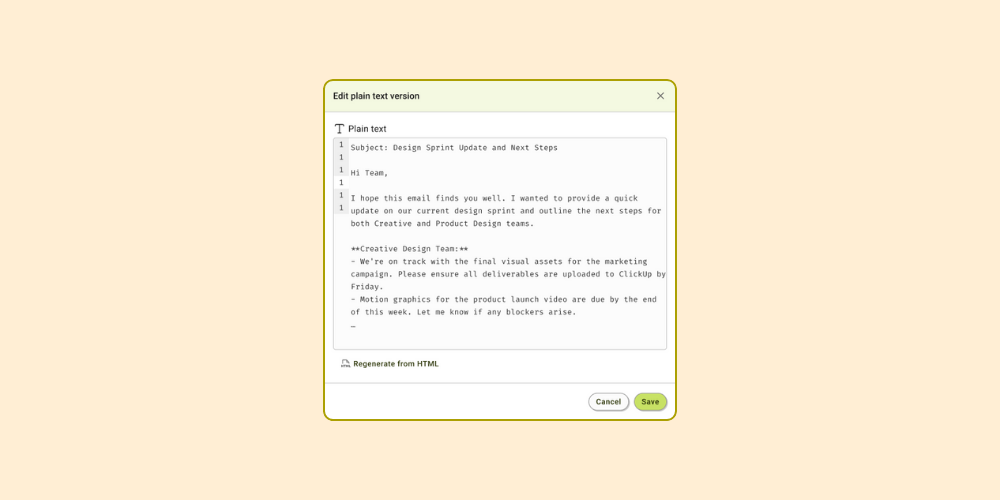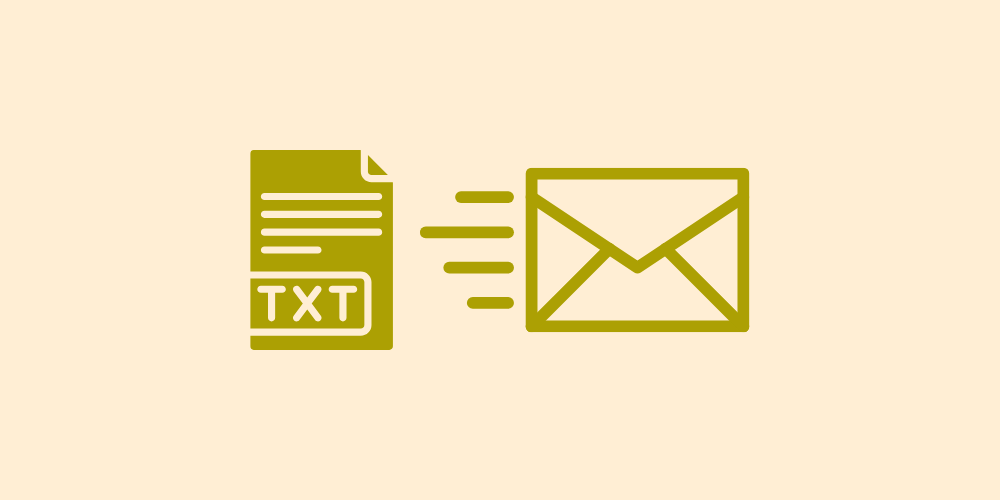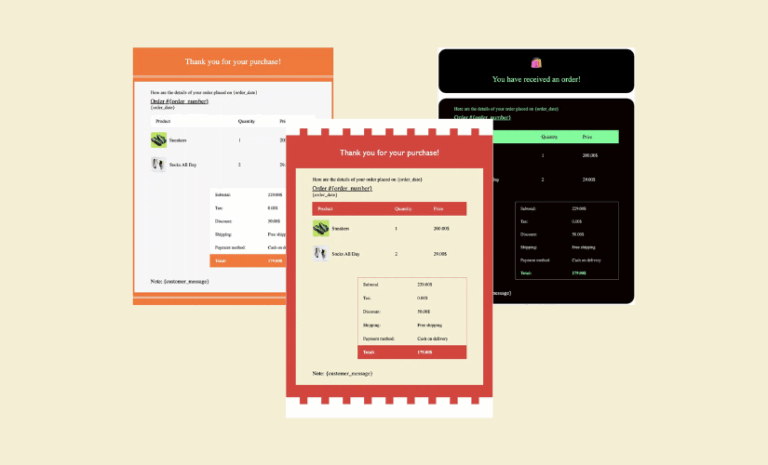Learn what a plain text version in campaign emails is. Discover why they are essential for email marketing, and how they enhance accessibility and compliance.
A plain text version in campaign emails is a simple, text-only format of the email without any HTML, images, or fancy styling. It only includes the basic text content, ensuring that people who can’t or prefer not to view HTML emails can still read the email. Most email marketing platforms offer the option to include this as a fallback for recipients whose email clients block HTML or when loading time and simplicity matter.
In an increasingly diverse digital landscape, where recipients may access their emails through various devices and platforms, the plain text version serves as a crucial fallback. It ensures that your message reaches all audiences, regardless of their email client or device capabilities. Furthermore, as privacy and security concerns grow among users, plain text emails can help bridge the gap, providing a straightforward, safe way to communicate.
This article will explore the significance of including a plain text version in your email marketing campaign emails, highlighting its benefits and demonstrating why it should be an integral part of your email strategy.
What Is Plain Text Version in Campaign Emails?
The plain text version in campaign emails is a simple, text-only format of an email that contains no HTML, images, or complex formatting. It consists solely of text, which means it lacks any styling, such as different fonts, colors, or embedded media.

Plain text emails are straightforward and ensure that the core message of the email is communicated clearly and effectively.
Key Characteristics of Plain Text Emails:
- No Formatting: Plain text emails are devoid of any HTML coding or design elements, making them clean and easy to read.
- Compatibility: They can be read on any device or email client, regardless of its capabilities. This ensures accessibility for all recipients, including those using older devices or specific email services.
- Lightweight: Plain text emails have a smaller file size compared to HTML emails, which means they load faster and are less likely to be impacted by connectivity issues.
The plain text version in campaign emails plays a vital role in effective email marketing. By providing a simple, accessible format, marketers can ensure that their messages reach a broader audience while also catering to the diverse preferences and needs of recipients. Incorporating a plain text version not only enhances deliverability but also promotes inclusivity, ensuring that all users can engage with your content.
The Importance of the Plain Text Version of Emails in Email Marketing Campaigns
While visually appealing HTML emails often dominate the landscape, it’s essential not to overlook the plain text version of your emails. A plain text email is a simplified, text-only format that offers several advantages, particularly in terms of accessibility, deliverability, and user experience.
Let’s take a look at some of the key reasons why you should include a plain text version in every campaign email.
Improves Email Deliverability by Passing Through Spam Filters
Some spam filters are configured to favor emails with a plain text version. Including a plain text version reduces the chances of your email being flagged as spam. These filters often look for both HTML and plain text components in emails to ensure they are not overly promotional or suspicious. Having a plain text version can signal to these filters that the email is legitimate, increasing its chances of reaching the inbox.
Avoids Being Blocked by High-Security Organizations
Emails sent to recipients in highly secure environments, like government agencies, banks, or large corporations, may have strict email policies that block HTML-based emails altogether. These organizations often prioritize security and may perceive HTML emails as a potential risk due to embedded links, tracking pixels, or hidden malware. Providing a plain text version ensures that your email can bypass these security restrictions and still reach the intended recipient.
Optimized for Devices and Clients with Storage or Bandwidth Limitations
Devices and email clients with limited storage or slow internet connections may prefer plain text emails, especially if the HTML version contains large images or complex formatting. HTML emails can be data-heavy, while plain text emails are lightweight and load faster. Sending a plain text version ensures that recipients with storage constraints or slower internet connections can still read your message without delays or failed downloads.
Accessible on Non-Traditional Devices like Smartwatches
Smartwatches, gaming consoles, and other non-traditional devices often lack the ability to properly render HTML emails. These devices prioritize speed and efficiency, and they may default to displaying the plain text version. By including a plain text version of your email, you ensure that your message is accessible on a broader range of devices, expanding your reach to recipients who might check emails from these platforms.
Enhances Accessibility for Visually Impaired Users with Screen Readers
Screen readers, which are used by visually impaired individuals, typically work better with plain text emails. HTML emails can confuse these devices with excessive formatting or embedded elements. By providing a plain text version, you ensure that the message is communicated clearly and efficiently, allowing screen readers to easily convey your content to users. This improves the accessibility of your emails and ensures that all recipients, regardless of their abilities, can engage with your message.
Improves Compatibility and Ensures Compliance
Not all email clients render HTML emails the same way, leading to potential issues with design, layout, and overall user experience. Depending on the platform, your HTML email could appear broken or poorly formatted, frustrating recipients. Some privacy-focused email providers, like ProtonMail, also strip down or block complex HTML content entirely for security and privacy reasons. Including a plain text version ensures that even if the HTML email doesn’t display correctly, or is blocked by privacy-focused platforms, recipients will still be able to view your content in a clean and readable format, maintaining compatibility and compliance across all email clients.
Supports Older Email Clients and Legacy Systems
Some older email clients or legacy systems may not fully support modern HTML email formats. These outdated clients could strip away images or misinterpret styles, making the email difficult to read. Sending a plain text version ensures that users on these systems can still access and engage with your content without technical glitches.
Reduces the Risk of Miscommunication Due to Design Errors
HTML emails rely on design elements such as fonts, colors, and images to convey a message, and if these elements don’t load correctly, the email can lose its intended impact or become difficult to understand. By including a plain text version, you eliminate the risk of design errors getting in the way of your message, ensuring that the core information always gets through, even if the HTML version fails to render properly.
How to Write a Plain Text Version in Campaign Emails
Creating an effective plain text version in campaign emails is essential for ensuring that your message is accessible to all recipients. Here are some key steps to help you craft a nice plain text email:
- Keep It Simple: Focus on clarity and conciseness. Use straightforward language and avoid jargon or complex sentences. Since there are no formatting options, make every word count.
- Structure Your Content: Use line breaks and spacing to organize your content. Clearly, separate sections with blank lines to enhance readability. A well-structured email will make it easier for recipients to digest the information.
- Write a Clear Subject Line: Just like in HTML emails, your subject line is crucial. Ensure it accurately reflects the content of your email and captures the reader’s attention.
- Include Essential Information: Clearly state the purpose of the email in the opening lines. Include any important dates, details, or calls to action that recipients need to know.
- Use Plain Language for Links: Since hyperlinks cannot be included, provide the full URLs for any links you want to share. For example, instead of “Visit our website,” use “Visit our website at www.example.com.”
- Include Contact Information: Ensure that your contact details, including email, phone number, and social media handles, are presented at the end of the email. This provides recipients with an easy way to reach you.
- Place unsubscribe link: Including an unsubscribe link is essential for compliance with email marketing regulations. Ensure that it is clear and easy for recipients to opt out of future emails.
What Not to Include in the Plain Text Version of Emails
There are some key things to avoid while writing a plain text version of campaign emails. Let’s take a look at them to write better plain-text emails for email marketing campaigns:
- Hyperlinks: Avoid using hyperlinks, as plain text emails cannot render clickable links. Instead, provide the full URL for any resources or websites you want to share.
- Images and Graphics: Do not attempt to include images or graphics. Plain text emails do not support visual content, so focus on conveying your message through text alone.
- Special Characters and Formatting: Refrain from using special characters, emojis, or any formatting options (like bold or italics). Stick to standard characters to ensure your message is displayed correctly across all devices and email clients.
- Long Blocks of Text: Avoid long, unbroken paragraphs. This can make the email difficult to read. Use line breaks and spacing to separate ideas and enhance readability.
- HTML Code: Do not include HTML tags or code snippets, as these will not be processed in a plain text email. Stick to plain language and clear communication.
- Confidential or Sensitive Information: Avoid including any sensitive information, such as personal data or confidential details, as plain text emails are less secure than HTML emails.
- Calls to Action with Complex Instructions: Keep calls to action straightforward. Avoid complex instructions that could confuse the reader. Ensure any actions you want them to take are clear and easy to follow.
- Multiple Unsubscribe Options: Don’t provide multiple methods for unsubscribing that could confuse recipients. A single, clear unsubscribe link is sufficient and helps comply with email regulations.
- Excessive Information: Avoid overwhelming your readers with too much information. Focus on the key points and make sure your email has a clear purpose.
- Attachments: Do not include attachments, as plain text emails do not support them. If you need to share documents, provide a link to download them instead.
By avoiding these elements, you can create a plain text email that is clear, concise, and effective in delivering your message to your audience.

Here’s a table outlining the dos and don’ts of writing a plain text version in campaign emails:
| Dos | Don’ts |
| Keep it Simple: Use clear and concise language. | Avoid Jargon: Steer clear of complex terms that might confuse the reader. |
| Structure Your Content: Use line breaks and spacing to organize your text. | Don’t Use Long Blocks of Text: Break up large paragraphs to improve readability. |
| Include Essential Information: Clearly state the purpose of the email. | Avoid Hyperlinks: Provide full URLs instead of clickable links. |
| Be Direct: Get straight to the point and ensure your message is clear. | Don’t Use Special Characters: Stick to standard characters to avoid display issues. |
| Test Your Email: Preview the email to ensure clarity and proper formatting. | Avoid HTML Code: Do not include HTML tags or code snippets. |
| Include Contact Information: Provide a way for recipients to reach you. | Don’t Include Attachments: Plain text emails do not support file attachments. |
| Place an Unsubscribe Link: Make it easy for recipients to opt out. | Avoid Excessive Information: Keep the email focused on key points. |
| Respect Privacy: Do not include sensitive or personal information. | Don’t Overwhelm Readers: Keep the email concise and to the point. |
Whether you are sending transactional emails or campaign emails, you can include a plain text version of your email if your email marketing tool supports it.
The plain text version in campaign emails plays a vital role in effective email marketing campaigns. By ensuring that your messages reach a wider audience, regardless of the devices or email clients they use, you enhance the chances of engagement and interaction. Moreover, as privacy concerns continue to rise, plain text emails offer a trustworthy alternative that fosters transparency and builds confidence among recipients.
Adding a plain text version in campaign emails alongside your HTML one is not just a best practice; it is an essential strategy that reflects your commitment to inclusivity and user experience. As you craft your email marketing strategy, remember that simplicity can be powerful. By embracing the plain text format, you can strengthen your communication efforts and create a lasting impact on your audience.



